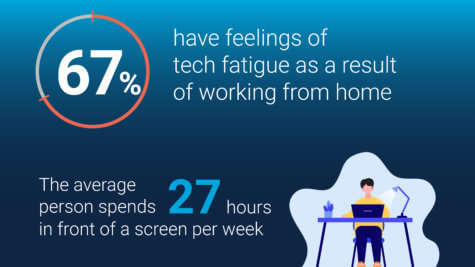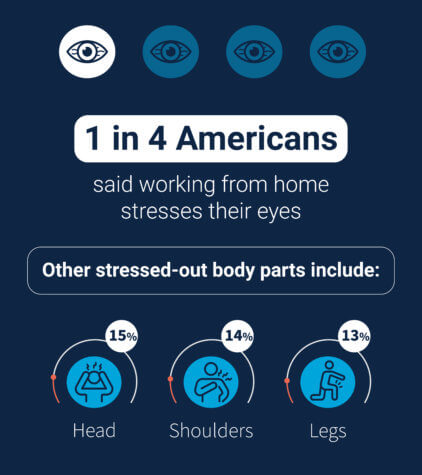NEW YORK — Working from home may have been the safest option for many Americans during the pandemic — but a new study finds it’s taking a toll on their bodies. A survey of 2,000 Americans finds that two in three respondents have suffered physical pain since they began working from home last year.
Results show that the average person wakes up with muscle and joint pain nine times per month. Similarly, respondents wake up with a headache or eye pain seven times per month.
With COVID restrictions loosened in some areas, 73 percent of Americans have returned to working in an office again, at least part time. One in six still working remotely full-time plan to return to the office in the near future, though this survey was taken prior to the sudden spike in Delta variant cases.
Tech fatigue from remote work a common issue for most now
 Commissioned by GlassesUSA.com and conducted by OnePoll, the study finds 67 percent have feelings of tech fatigue — feeling physically tired and stressed by technology use — as a result of working from home.
Commissioned by GlassesUSA.com and conducted by OnePoll, the study finds 67 percent have feelings of tech fatigue — feeling physically tired and stressed by technology use — as a result of working from home.
Out of every body part, peoples’ eyes feel the most stress (26%). Other stressed out body parts include the head (15%), shoulders (14%), and legs (13%). For 68 percent of remote workers, stress and their at-home environment are making their primary senses more sensitive than before COVID.
Forty-five percent of those who think their senses are more sensitive now believe remote work is especially affecting their eyesight. Sixty-three percent say their eyes have been constantly bothering them over the last year.
“There’s been an increase in both search and demand for blue light blocking lenses as the Pandemic progressed,” says GlassesUSA.com CEO Daniel Rothman in a statement. “Screen time has drastically increased as it has become our means of social interaction as well as work. People report fewer headaches, improved sleep and less digital eye strain after using blue light lenses.”
Since working from home, 75 percent have started to look at new ways to take care of their bodies, with nearly as many (72%) looking for new ways to de-stress at home. To deal with stress, respondents add they’ve started drinking more water (56%) and taking more naps (47%).
Are screens increasing stress?
 The average American spends 27 hours in front of a screen per week, causing 46 percent to turn off their screens at certain times of the day to prevent eye strain.
The average American spends 27 hours in front of a screen per week, causing 46 percent to turn off their screens at certain times of the day to prevent eye strain.
People usually turn off their screens in the evening and 30 percent of respondents who do so log off from 4:01 p.m. to 8 p.m. Another 32 percent do so between 8:01 p.m. and midnight. More than three-quarters (77%) of respondents feel a physical difference in themselves if they haven’t had enough water throughout the day.
Seventy-two percent of remote workers believe going back to working in-person is the motivation they need to start taking better care of themselves. Since working from home, 57 percent have given up their exercise routines, carrying their stress with them throughout the day.
“A well-balanced diet, low impact movement are crucial to our overall health and ocular wellness. Maintaining personal hygiene and washing hands frequently can help to prevent us from spreading viruses to our eyes,” reveals GlassesUSA.com eye-health expert Sandra Young, OD. “Because of increased screen time demands, it is important to take regular breaks from looking at screens, reduce focusing fatigue by looking out of the window or at an object 20 feet away for 20 seconds every 20 minutes. It is also recommended to use blue light blocking glasses to help filter the harmful rays emitted from our digital devices.”
